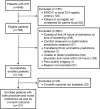Clinician judgment vs formal scales for predicting intracerebral hemorrhage outcomes
- PMID: 26674335
- PMCID: PMC4731687
- DOI: 10.1212/WNL.0000000000002266
Clinician judgment vs formal scales for predicting intracerebral hemorrhage outcomes
Abstract
Objective: To compare the performance of formal prognostic instruments vs subjective clinical judgment with regards to predicting functional outcome in patients with spontaneous intracerebral hemorrhage (ICH).
Methods: This prospective observational study enrolled 121 ICH patients hospitalized at 5 US tertiary care centers. Within 24 hours of each patient's admission to the hospital, one physician and one nurse on each patient's clinical team were each asked to predict the patient's modified Rankin Scale (mRS) score at 3 months and to indicate whether he or she would recommend comfort measures. The admission ICH score and FUNC score, 2 prognostic scales selected for their common use in neurologic practice, were calculated for each patient. Spearman rank correlation coefficients (r) with respect to patients' actual 3-month mRS for the physician and nursing predictions were compared against the same correlation coefficients for the ICH score and FUNC score.
Results: The absolute value of the correlation coefficient for physician predictions with respect to actual outcome (0.75) was higher than that of either the ICH score (0.62, p = 0.057) or the FUNC score (0.56, p = 0.01). The nursing predictions of outcome (r = 0.72) also trended towards an accuracy advantage over the ICH score (p = 0.09) and FUNC score (p = 0.03). In an analysis that excluded patients for whom comfort care was recommended, the 65 available attending physician predictions retained greater accuracy (r = 0.73) than either the ICH score (r = 0.50, p = 0.02) or the FUNC score (r = 0.42, p = 0.004).
Conclusions: Early subjective clinical judgment of physicians correlates more closely with 3-month outcome after ICH than prognostic scales.
© 2015 American Academy of Neurology.
Figures
Comment in
-
Intracerebral haemorrhage: Prognostic scales versus clinical judgment in ICH.Nat Rev Neurol. 2016 Apr;12(4):192-3. doi: 10.1038/nrneurol.2016.11. Epub 2016 Feb 12. Nat Rev Neurol. 2016. PMID: 26868679 No abstract available.
References
-
- van Asch CJ, Luitse MJ, Rinkel GJ, van der Tweel I, Algra A, Klijn CJ. Incidence, case fatality, and functional outcome of intracerebral haemorrhage over time, according to age, sex, and ethnic origin: a systematic review and meta-analysis. Lancet Neurol 2010;9:167–176. - PubMed
-
- Becker KJ, Baxter AB, Cohen WA, et al. Withdrawal of support in intracerebral hemorrhage may lead to self-fulfilling prophecies. Neurology 2001;56:766–772. - PubMed
-
- Hemphill JC, III, Newman J, Zhao S, Johnston SC. Hospital usage of early do-not-resuscitate orders and outcome after intracerebral hemorrhage. Stroke 2004;35:1130–1134. - PubMed
Publication types
MeSH terms
Grants and funding
LinkOut - more resources
Full Text Sources

